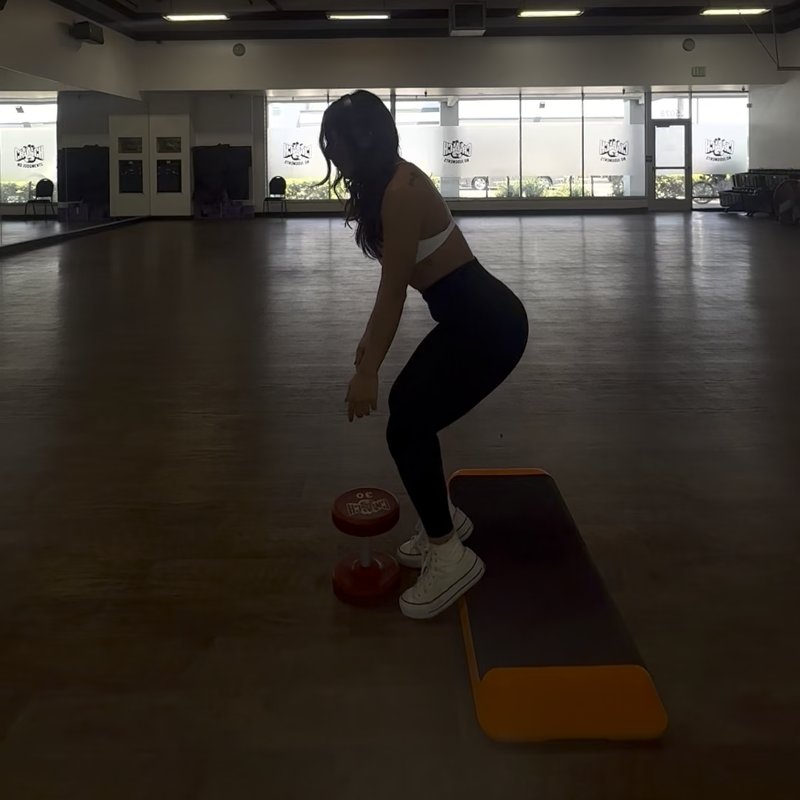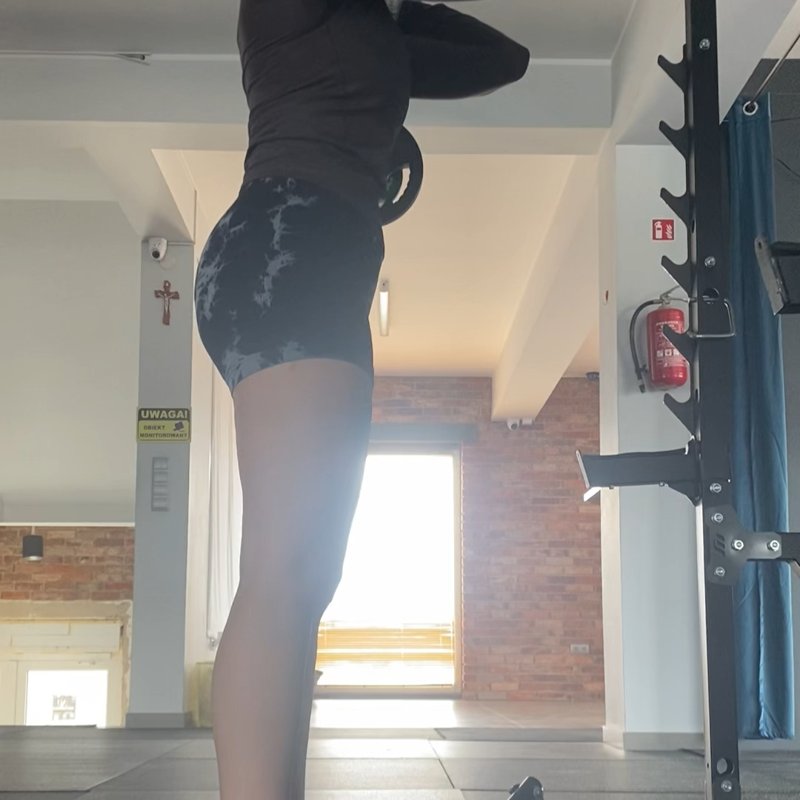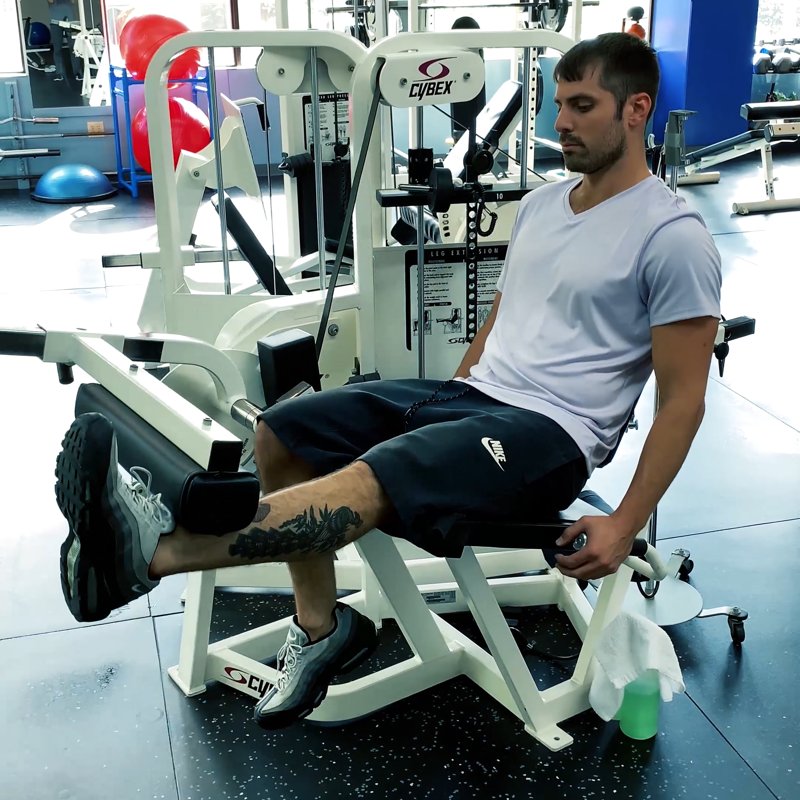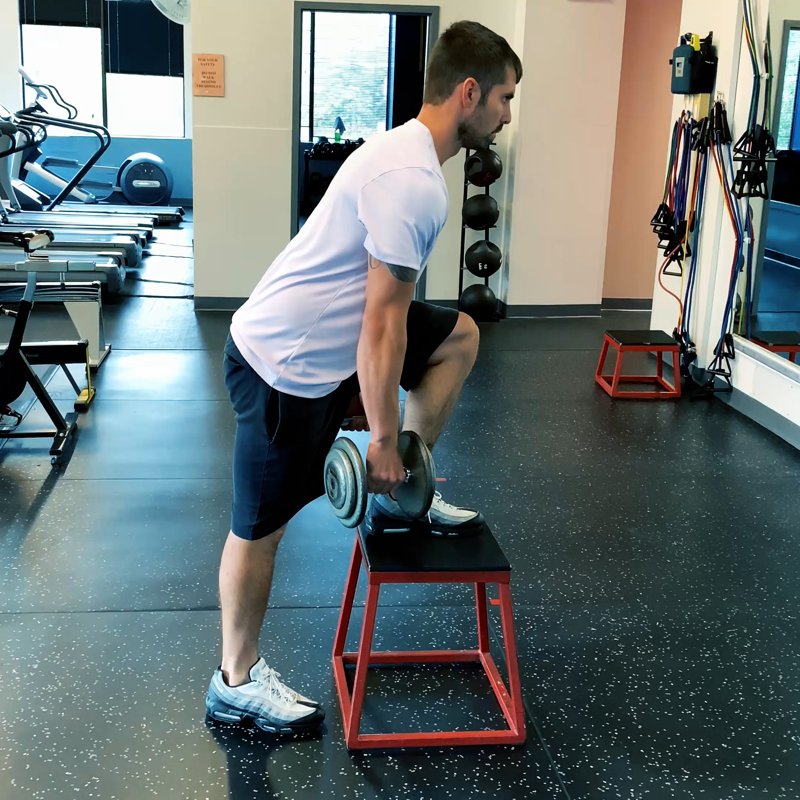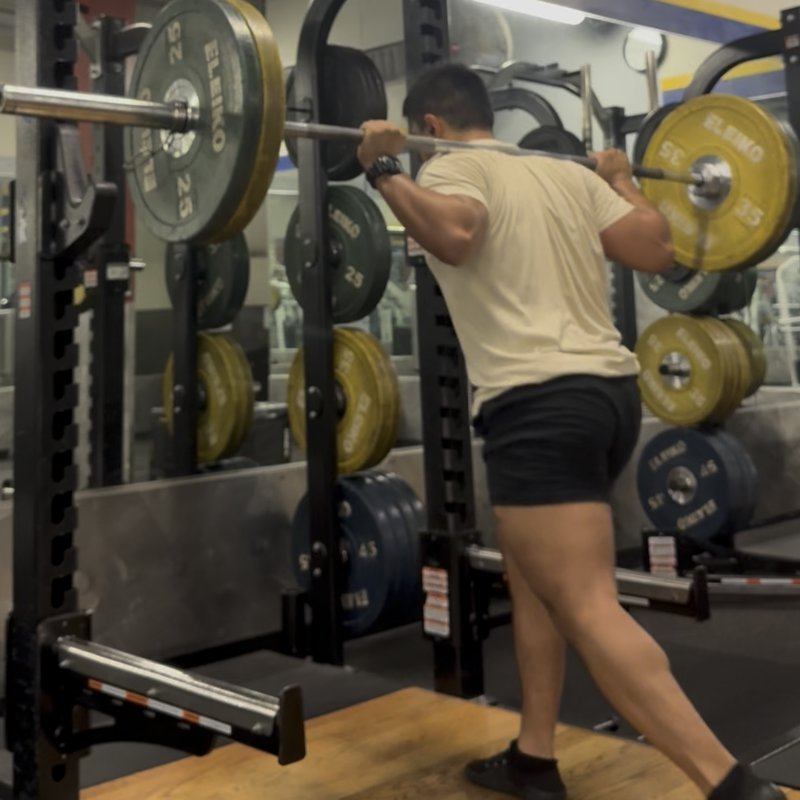Goblet Squat: The Ultimate Guide
The Goblet Squat is a beginner-friendly squat variation performed while holding a weight in front of the chest, which promotes proper squat mechanics while targeting the quadriceps, glutes, and core musculature.
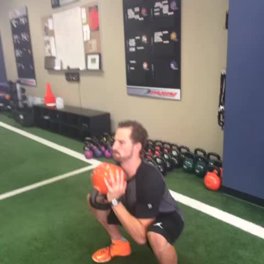
Quick Facts
Key Benefit
Improved squat mechanics and quad/core development
Primary Muscles
Glutes, Hamstrings, Quadriceps
Secondary Muscles
Abdominals, Calves, Erector Spinae, Forearms, Hip Adductors, Traps
Equipment
dumbbells (optional), kettlebell (optional)
Difficulty
Beginner
Type
Compound
In This Guide
Ready to master the Goblet Squat?
Track your progress, see improvements over time, and build strength consistently.
Download GravitusThe Goblet Squat stands as one of the most valuable and accessible squat variations, benefiting lifters of all experience levels despite its simple appearance. Named for the way the weight is held—like a goblet or chalice against the chest—this movement primarily targets the quadriceps, glutes, and hamstrings while also significantly engaging the core and upper back. What makes the goblet squat particularly valuable is how it naturally promotes proper squat mechanics. The front-loaded position encourages an upright torso, proper depth, and good ankle mobility—correcting many common squat faults without requiring extensive coaching cues. The anterior weight placement also creates a counterbalance that makes achieving proper depth easier for many lifters. For beginners, it serves as an excellent teaching tool and introduction to loaded squatting patterns. For intermediate and advanced lifters, it offers a joint-friendly option for higher repetition work, technique refinement, or as an accessory to heavier squat variations. The movement also creates significant core engagement as the midsection works to stabilize the spine against the anterior load. Whether your goal is to build strength fundamentals, improve squat mechanics, develop leg and core musculature, or simply add an effective exercise to your routine, the goblet squat delivers exceptional results with minimal equipment and technical demands.
Benefits of Goblet Squats
The goblet squat offers several unique advantages compared to other squat variations.
Teaches Proper Squat Mechanics
The front-loaded position naturally promotes an upright torso, appropriate depth, and proper foot pressure—reinforcing good squatting habits.
Core Development
The anterior weight placement creates significant anti-flexion demands on the core musculature, building functional midsection strength.
Upper Back Engagement
Holding the weight against the chest requires the upper back muscles to work isometrically, improving posture and shoulder stability.
Joint-Friendly Loading
The movement allows for effective leg training with less compressive loading on the spine compared to back-loaded squats.
Accessibility
Requires minimal equipment and technical skill, making it suitable for home workouts and beginners alike.
Ankle Mobility Enhancement
The upright torso position encourages and develops ankle dorsiflexion, which carries over to other squatting movements.
Proper Form & Technique
Setup
- Select an appropriate dumbbell or kettlebell that challenges you but allows for proper form.
- For a dumbbell, hold it vertically by one end with both hands cupping the upper portion.
- For a kettlebell, grasp it by the handles with both hands, keeping the weight portion down.
- Hold the weight close to your chest, just below your chin, with elbows pointing down toward the floor.
- Stand with feet slightly wider than shoulder-width apart, toes turned out slightly (about 5-15 degrees).
- Brace your core by taking a deep breath into your diaphragm and engaging your midsection.
- Pull your shoulders back and down to create a stable upper back position.
- Distribute your weight evenly across your entire foot, with a slight emphasis on the heels and outer edges.
Descent
- Initiate the movement by breaking at the hips and knees simultaneously.
- Begin sitting back and down as if aiming for a chair behind you.
- Keep your chest up and core engaged throughout the movement.
- Allow your knees to track in line with your toes—avoid excessive inward collapse or outward push.
- Maintain the weight position tight against your chest throughout the descent.
- Continue lowering until your thighs are at least parallel to the ground, or deeper if mobility allows.
- At the bottom position, focus on keeping your heels firmly planted on the floor.
- Maintain a neutral spine position—avoid excessive rounding or arching of the lower back.
Ascent
- Pause briefly at the bottom position to eliminate momentum and ensure control.
- Drive through your mid-foot and heels to begin standing up, pushing the floor away from you.
- Keep your chest up and elbows down, maintaining the weight position against your chest.
- Focus on engaging your quadriceps and glutes to power the upward movement.
- Extend your hips and knees simultaneously until you return to the starting position.
- Maintain core tension and proper posture throughout the ascent.
- Exhale as you approach the top position, completing the repetition with hips and knees fully extended.
- Reset your breath and position briefly before beginning the next repetition.
Key Form Tips
Elbow Position
Keep elbows pointing down toward the floor to maintain upper back tension and prevent the weight from drifting forward.
Knee Tracking
Ensure knees track in line with toes throughout the movement, avoiding inward collapse which can stress the joints.
Torso Angle
Maintain a relatively upright torso position, which the front-loaded weight naturally facilitates.
Breathing
Take a deep breath into your diaphragm before descending, hold throughout the movement, and exhale during the final portion of the ascent.
Depth
Aim for thighs at least parallel to the floor, using the counterbalance of the weight to achieve proper depth.
Muscles Worked
Primary Muscles
- Quadriceps: The four muscles at the front of the thigh (rectus femoris, vastus lateralis, vastus medialis, vastus intermedius) that extend the knee during the ascent phase.
- glutes: The largest muscle in the buttocks that powers hip extension during the standing portion of the movement.
- Hamstrings: The three muscles at the back of the thigh that contribute to hip extension and provide stability during the squat.
Secondary Muscles
- abdominals: The rectus abdominis, obliques, and transverse abdominis work isometrically to stabilize the spine against the front-loaded weight.
- traps: The trapezius, rhomboids, and rear deltoids contract isometrically to maintain proper posture and weight position.
- hip adductors: The inner thigh muscles assist in stabilizing the hip and knee during the squatting motion.
- Erector Spinae: The muscles running along the spine that work to maintain a neutral back position throughout the movement.
- Calves: The gastrocnemius and soleus provide ankle stability throughout the movement, particularly at the bottom position.
- Forearms: The gripping muscles work isometrically to maintain hold on the weight throughout the exercise.
Common Mistakes and How to Fix Them
Letting the Weight Pull You Forward
Allowing the weight to drift away from your chest, which can round your upper back and shift your center of gravity. Keep the weight tightly pressed against your sternum throughout the entire movement. Focus on pulling your elbows down and in rather than allowing them to flare out or rise up. If the weight consistently drifts forward, it may be too heavy for proper execution—reduce the load until you can maintain proper positioning. For dumbbell goblet squats, hold the weight by cupping the top head rather than holding the handle. For kettlebells, ensure you're gripping the handles with both hands and keeping the bell portion down.
Heels Rising Off the Floor
Lifting the heels during the descent indicates limited ankle mobility or improper weight distribution. Focus on sitting back into the squat rather than primarily bending at the knees. Distribute weight across the entire foot with a slight bias toward the heels and outer foot. If ankle mobility is limiting your ability to keep heels down, consider temporarily elevating heels slightly on weight plates (¼-½ inch) while working on mobility. Incorporate specific ankle mobility drills into your warm-up routine, such as weighted ankle stretches and calf foam rolling. The counterbalance of the goblet position should actually help keep heels down compared to unweighted squats—if they're still rising, revisit the fundamentals of squat mechanics.
Insufficient Depth
Not squatting deep enough to achieve optimal muscle recruitment and mobility benefits. The goblet squat naturally facilitates deeper squatting due to the counterbalance effect. Aim to lower until your thighs are at least parallel to the floor, or deeper if your mobility allows. If depth is limited by mobility rather than strength, incorporate hip and ankle mobility work into your routine. Consider using the "squat to box" technique—squatting to a box or bench set at your target depth—to develop confidence and positional awareness. Remember that proper depth varies somewhat between individuals based on anatomy, but most people should strive for the thigh-parallel position at minimum.
Knees Caving Inward
Allowing knees to collapse inward (valgus) during the movement increases injury risk and reduces effectiveness. Focus on actively pushing your knees outward in line with your toes throughout the movement. Cue yourself to "spread the floor apart with your feet" to engage the hip external rotators and maintain proper knee position. If knee positioning is persistently challenging, consider using a resistance band placed just above the knees during warm-up sets as a proprioceptive reminder. Strengthening the hip abductors and external rotators with targeted exercises (lateral band walks, clamshells, etc.) can address underlying weaknesses that contribute to knee cave.
Rounding the Lower Back
Excessive flexion of the lumbar spine during the bottom portion of the squat. Maintain a neutral spine position by engaging your core before initiating the descent and keeping it braced throughout the movement. The front-loaded goblet position actually helps promote a more upright torso and proper spinal alignment compared to many other squat variations. If you notice persistent lower back rounding at depth, consider limiting your range of motion temporarily to where you can maintain proper position. Gradually increase depth as core strength and mobility improve. For those with limited mobility, a slightly wider stance can sometimes help maintain proper back position at the bottom of the squat.
Rushing Through Repetitions
Performing repetitions too quickly reduces muscle engagement and learning benefits. The goblet squat is particularly valuable for building proper movement patterns, which requires mindful execution. Control both the descent and ascent phases of the movement, avoiding bouncing at the bottom or using momentum. Consider implementing a specific tempo—perhaps 3 seconds down, 1-second pause at the bottom, 2 seconds up—to ensure quality movement. Focus on feeling the working muscles throughout the entire range of motion. For beginners especially, prioritize perfect repetitions over quantity or speed to develop proper motor patterns that will transfer to other squat variations.
Exercise Variations
Equipment Variations
-
Kettlebell Goblet Squat
Using a kettlebell held by the handles with the bell portion down, which creates a slightly different center of gravity compared to a dumbbell.
-
Dumbbell Goblet Squat
Holding a dumbbell vertically by one end, which some find provides a more comfortable grip position for heavier weights.
-

Medicine Ball Goblet Squat
Using a medicine ball held against the chest, which can be more comfortable for those with wrist or forearm discomfort.
-

Weight Plate Goblet Squat
Holding a weight plate with hands on either side, creating a wider grip that some find more stable for maintaining upper back position.
Technical Variations
-

Pause Goblet Squat
Adding a deliberate 2-4 second pause at the bottom position to eliminate momentum and increase time under tension.
-
Tempo Goblet Squat
Controlling the speed of different phases of the movement, such as a slow 4-second descent followed by a more explosive ascent.
-

1½ Goblet Squat
Performing a full squat, coming halfway up, squatting back down, and then standing fully—counting as one complete repetition.
-

Goblet Pulse Squat
Performing small, pulsing partial movements at the bottom position to increase metabolic stress and endurance in the working muscles.
Position Variations
-
Narrow Stance Goblet Squat
Using a stance slightly narrower than shoulder-width to increase range of motion demands and emphasize quadriceps involvement.
-
Wide Stance Goblet Squat
Using a wider stance with toes turned out more significantly to increase adductor and inner quad engagement.
-
Elevated Heel Goblet Squat
Placing small weight plates under the heels to accommodate limited ankle mobility and allow for proper depth with more upright posture.
-
Split Stance Goblet Squat
Positioning one foot slightly in front of the other to create a hybrid between a squat and a lunge, challenging balance and unilateral strength.
Frequently Asked Questions
The appropriate weight for goblet squats depends on your training experience, current strength level, and specific goals. Unlike barbell squats where loading potential is virtually unlimited, goblet squats eventually reach a practical ceiling based on what can be comfortably held in the goblet position. For beginners, start light (5-15 pounds) to master proper movement patterns before adding weight. Intermediate lifters typically work with 25-50 pounds for moderate repetitions (8-12), while advanced lifters might use 50-100+ pounds for lower repetition work. Unlike some exercises where heavier is always better, goblet squats remain valuable even with moderate weights due to their excellent mechanics and core engagement. For many trainees, once they can handle 70+ pounds for 8-10 repetitions with perfect form, it may be time to start incorporating front squats or other barbell variations to continue strength progression, while keeping goblet squats in the program for technique work and higher repetition sets. Rather than focusing solely on the amount of weight used, select a resistance that allows you to: (1) maintain perfect form throughout the set, (2) achieve appropriate depth with proper back position, and (3) feel the work primarily in the intended muscles rather than just struggling with holding the weight.
Neither exercise is inherently "better"—they serve different purposes and complement each other effectively in a well-designed program. Goblet squats excel at teaching proper squat mechanics, place less compressive load on the spine, require minimal equipment, and naturally promote an upright torso position that many lifters find more comfortable. They're particularly valuable for beginners learning the squat pattern, those with certain back issues, or as a joint-friendly option for higher repetition work. Barbell squats (back or front variations) allow for substantially heavier loading, making them superior for maximum strength development once basic technique is established. They also create greater systemic stress and hormonal response due to the heavier loads possible. For most trainees, both exercises have a place in their training toolkit. Goblet squats might be emphasized early in a training career, during technique-focused phases, or as an accessory movement to barbell work. Barbell squats might become the primary lower body movement once sufficient technique and strength are developed. Many experienced lifters continue to use goblet squats as warm-up drills, for metabolic conditioning, or during deload weeks even after transitioning to barbell variations for their main strength work.
For most people, squatting until the thighs are at least parallel to the floor (femurs horizontal) provides an effective range of motion that engages the quadriceps, hamstrings, and glutes through a substantial portion of their functional range. The goblet squat actually facilitates achieving proper depth for many lifters due to its counterbalance effect—the anterior weight helps keep the torso more upright, making it easier to maintain balance in deeper positions compared to unweighted squats. If mobility allows and it feels comfortable, squatting below parallel (where hip crease drops below the top of the knee) can provide additional benefits for glute activation, hip mobility, and overall lower body development. However, depth should never come at the expense of proper form. If you notice your lower back rounding, heels rising, or knees caving inward as you descend deeper, limit your depth to the point where you can maintain proper alignment. The appropriate depth varies somewhat between individuals based on limb proportions, hip structure, and mobility factors, so focus on quality of movement within your available range rather than forcing a predetermined position that might not be suitable for your individual anatomy.
Most people respond well to training each major muscle group 2-3 times per week with sufficient recovery between sessions. For goblet squats specifically, incorporating them 2-3 times weekly is typically optimal for most trainees. If following a body part split, you might perform this exercise on your designated leg day once per week. With an upper/lower split, they could be included in both of your weekly lower body sessions. For full-body training, they might appear in 2-3 of your sessions each week. The goblet squat is versatile enough to be programmed in various ways—as a main strength movement (typically earlier in a training career), as a technique-focused accessory to other squat variations, as a metabolic conditioning tool, or even as a warm-up drill before heavier squatting. Since they generally create less systemic fatigue than heavy barbell squats, many lifters find they can perform goblet squats more frequently without recovery issues. Consider your overall lower body training volume and the other exercises in your program when determining optimal frequency. If you're concurrently performing other demanding lower body exercises like deadlifts, lunges, or barbell squats, you might position goblet squats as an accessory movement 1-2 times weekly. If they're your primary squatting pattern, 2-3 weekly sessions with progressive loading would be more appropriate.
Goblet squats can absolutely serve as a primary squatting movement in many scenarios, though they do have loading limitations compared to barbell variations. For beginners developing basic squatting strength and technique, goblet squats might be the only squat variation needed for several months of training. They teach proper mechanics while providing sufficient stimulus for initial strength and muscle development. For those with certain equipment limitations (training at home with only dumbbells or kettlebells), goblet squats can function as the main lower body exercise indefinitely, particularly when combined with other movements like lunges, step-ups, or deadlift variations to create comprehensive lower body development. Individuals with specific back issues that make barbell squats uncomfortable might permanently substitute goblet squats as their primary squatting pattern, as the front-loaded position typically creates less spinal compression. However, for intermediate to advanced trainees focusing on maximal strength development, goblet squats will eventually reach a ceiling where the weight that can be held in the goblet position becomes the limiting factor rather than leg strength. At this point, incorporating barbell variations (particularly front squats, which maintain many of the same mechanical advantages) becomes necessary for continued strength progression. Even when they're no longer your primary strength movement, goblet squats remain valuable as technique work, warm-up drills, metabolic conditioning tools, or during deload phases.
Video Demonstrations
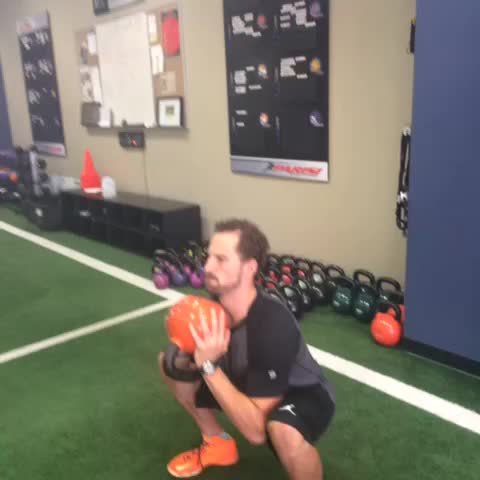
Log in to watch video demonstrations
Login to Watch3 video demonstrations available
Tips from the Community
-

Touch your knees with your elbows and then come up.
Track your progress with Gravitus
Download Gravitus to log your workouts, track your progress, and join a community of fitness enthusiasts.

Helpful Resources
One Rep Max Calculator
Find your one rep max for any exercise without maximal testing. Essential for developing effective strength training programs.
Calculate 1RMWorkout Programs
Follow structured workout programs created by fitness professionals to maximize your strength and muscle gains.
View Programs